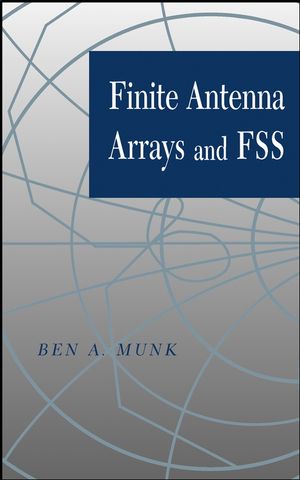Finite Antenna Arrays and FSSISBN: 978-0-471-27305-9
Hardcover
392 pages
July 2003, Wiley-IEEE Press
 This is a Print-on-Demand title. It will be printed specifically to fill your order. Please allow an additional 10-15 days delivery time. The book is not returnable.
|
||||||
Preface.
Acknowledgments.
Symbols and Definitions.
1. Introduction.
1.1 Why Consider Finite Arrays?
1.2 Surface Waves Unique to Finite Periodic Structures.
1.3 Effects of Surface Waves.
1.4 How Do We Control the Surface Waves?
1.5 Common Misconceptions.
1.6 Conclusion.
1.7 Problems.
2. On the RCS of Arrays.
2.1 Introduction.
2.2 Fundamentals of Antenna RCS.
2.3 How to Obtain a Low σtot by Cancellation (Not Recommended).
2.4 How Do We Obtain Low σtot Over a Broad Band?
2.5 A Little History.
2.6 On the RCS of Arrays.
2.7 An Alternative Approach: The Equivalent Circuit.
2.8 On the Radiation from Infinite vs. Finite Arrays.
2.9 On Transmitting, Receiving and Scattering Radiation Pattern of Finite Arrays.
2.10 Minimum versus Non-Minimum Scattering Antennas.
2.11 Other Non-Minimum Scattering Antennas.
2.12. How to Prevent Coupling Between the Elements Through the Feed Network.
2.12 How to Eliminate Backscatter Due to Tapered Aperture Illumination.
2.13 Common Misconceptions.
2.15 Summary.
2.16 Problems.
3. Theory.
3.1 Introduction.
3.2 The Vector Potential and the H-Field for Column Arrays of Hertzian Elements.
3.3 Case I: Longitudinal Elements.
3.4 Case II: Transverse Elements.
3.5 Discussion.
3.6 Determination of the Element Currents.
3.7 The Double Infinite Arrays with Arbitrary Element Orientation.
3.8 Conclusions.
3.9 Problems.
4. Surface on Passive Surfaces of Finite Extent.
4.1 Introduction.
4.2 Model.
4.3 The Infinite Array Case.
4.4 The Finite Array Case Excited by Generators.
4.5 The Element Currents on a Finite Array Excited by an Incident Wave.
4.6 How the Surface Waves are Excited on a Finite Array.
4.7 How to Obtain the Actual Current Components.
4.8 The Bistatic Scattered Field from a Finite Array.
4.9 Parametric Study.
4.10 How to Control Surface Waves.
4.11 Finite Tuning the Load Resistors at a Single Frequency.
4.12 Variation with Angle of Incidence.
4.13 The Bistatic Scattered Field.
4.14 Previous Work.
4.15 On Scattering from Faceted Radomes.
4.16 Effects of Discontinuities in the Panels.
4.17 Scanning in the E-plane.
4.18 Effect of a Groundplane.
4.19 Common Misconceptions Concerning Element Currents on Finite Arrays.
4.20 Conclusion.
4.21 Problems.
5. Finite Active Arrays.
5.1 Introduction.
5.2 Modeling of a Finite x Infinite Groundplane.
5.3 Finite x Infinite Array with an FSS Groundplane.
5.4 Micro Management of the Backscattered Field.
5.5 The Model for Studying Surface Waves.
5.6 Controlling Surface Waves on Finite FSS Groundplanes.
5.7 Controlling Surface Waves on Finite Arrays of Active Elements with FSS Groundplane.
5.8 The Backscatterd Fields from the Triads in a Large Array.
5.9 On the Bistatic Scattered Field from a Large Array.
5.10 Further Reduction: Broadband Matching.
5.11 Common Misconceptions.
5.12 Conclusion.
5.13 Problems.
6. Broadband Wire Arrays.
6.1 Introduction.
6.2 The Equivalent Circuit.
6.3 An Array with Groundplane and No Dielectric.
6.4 Practical Layouts of Closely Spaced Dipole Arrays.
6.5 Combination of the Impedance Components.
6.6 How to Obtain Grater Braodwidth.
6.7 Array with a Groundplane and a Single Dielectric Slab.
6.8 Actual Calculated Case: Array with Groundplane and Single Dielectric Slab.
6.9 Array with Groundplane and Two Dielectric Slab.
6.10 Comparison Between the Single and Double Slab Array.
6.11 Calculated Scan Impedance for Array with Groundplane and Two Dielectric Slabs.
6.12 Common Misconceptions.
6.13 Conclusions.
7. An Omnidirectional Antenna with Low RCS.
7.1 Introduction.
7.2 The Concept.
7.3 How Do We Feed the Elements?
7.4 Calculated Scattering Pattern for Omnidirectional Antenna with Low RCS.
7.5 Measured Backscatter from a Low RCS Omnidirectional Antenna.
7.6 Common Misconceptions.
7.7 Conclusions and Recommendations.
8. The RCS of Two-Dimensional Parabolic Antennas.
8.1 The Major Scattering Components.
8.2 Total Scattering from a Parabolic Reflector with a Typical Feed.
8.3 Practical Execution of the Low RCS Feed.
8.4 Out of Band Reduction.
8.5 Common Misconceptions on Edge Currents.
8.6 Conclusion.
9. Aperiodicity: Is it a Good Idea?
9.1 Introduction.
9.2 General Analysis of Periodic Structures with Perturbation of Element Loads and/or Inter-element Spacings.
9.3 Perturbation of Arrays of Tripoles.
9.4 Making Use of Our Observations.
9.5 Anomalies due to Insufficient Number of Models.
9.6 Aperiodicity on Finite Arrays.
9.7 Conclusions.
10. Summary and Final Remarks.
10.1 Summary.
10.2 Are We Going in the Right Direction?
10.3 Let Use Make Up!
Appendix A. Determination of Transformation and Position Circles.
Appendix B. Broadband Matching.
Appendix C. Meander-Line Polarizers for Oblique Incidence.
Appendix D. On the Scan versus the Embedded Impedance.
References.
Index.



